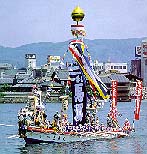 The Highlights of The Horanenya The Highlights of The Horanenya
Makeup
 On the Kaitenma boats, men in 'Kabuki'costume handle blade shaped oars, while others dress as women and wave batons. Both groups wear 'Kabuki-style' make-up. On the Kaitenma boats, men in 'Kabuki'costume handle blade shaped oars, while others dress as women and wave batons. Both groups wear 'Kabuki-style' make-up.
The dancers all require special wigs and make-up, however, as there are no longer any specialists in that field living in the area, each region brings in their own specialist from Kyoto.
Songs
The title song of the Horanenya is a workman's song sung loudly in order to keep the rowing in time. The word Horanenya can be written in Japanese in two ways either as
" 豊来栄弥 or 宝来遠弥 ",
both ways include a fervent wish for an abundant harvest.
Each of the five areas has its own song, sung in its own distinctive melody. Its a sound that lifts the spirit. Its also fun listening to the voices of the different areas competing with each other.
Costumes
The costumes worn by the men standing at the bow of the ship brazening the sword shaped oars in a heroic manner are ordered specially from Kyoto. The designs on these costumes reflect the traditions of each area. The cord worn around the waist is a smaller version of that worn by champion sumo wrestlers in spectacular colours of red, white and yellow etc, while the apron worn under the cord is an imitation of a Sumo wrestler's belt and done in gorgeous embroidery. This is also ordered in specially from Kyoto.
 On the arms are worn the 'Tehan' and 'Teoi', materials covering the arm down as far as the back of the hand. On the feet are worn straw sandels, where two pairs have been sewn together to make one pair. On the arms are worn the 'Tehan' and 'Teoi', materials covering the arm down as far as the back of the hand. On the feet are worn straw sandels, where two pairs have been sewn together to make one pair.
Those in the guise of women are attendants, brandishing their batons. Over the long underwear are worn specially dyed clothes. The highlight of this festival is seeing both those waving the swords and batons dancing in unison.
The Dance
 The Oar dance was introduced to the Horanenya at the end of the Edo era by a boatman named Shigezo from the fishing village of Kagamura on the Japan Sea. He had learned this dance in the Echigo region and was then invited to each region to teach it. The Oar dance was introduced to the Horanenya at the end of the Edo era by a boatman named Shigezo from the fishing village of Kagamura on the Japan Sea. He had learned this dance in the Echigo region and was then invited to each region to teach it.
The dance won a lot of acclaim in those days.
Just like the singing the dance performed in each of the five regions varies between each region.
The young dancer performs his dance as he points the spear shaped oar towards the Gods and holds his right hand over his forehead looking towards the sky.
Meanwhile on top of four 'to' barrels (one 'to' is equivalent to eighteen liters
), the attendant deports the upper half of his body arrogently, waving the batons towards the sky facinating the onlookers.
Both groups pride in passing on this tradition is evident in their ecstatic dancing.
The Boats
 This festival of the Gods began at the beginning of the Edo period around the time of Naomasa Matsudaira. From the beginning it has taken place every twelve years.
This festival of the Gods began at the beginning of the Edo period around the time of Naomasa Matsudaira. From the beginning it has taken place every twelve years.
Up until 1958 the boats took off from the moat around the castle. However, as the water in the moat has became too shallow, to-day, the boats take off from the shores of Lake Shinji.
The hundred or so vessels lead by the Hanabiki boat, the Kiyome boat, the Kaidenma boat, the Shinki boat, the Mikoshi boat and the Shinno boat together with the boats of parishoners of both Shrines form a line of about one kilometre.
The Kaitenma boats with the dancers on board sail up and down between the Shinjiko Ohashi bridge and the Kunibiki Ohashi bridge entertaining the onlookers on the shore.
Formerly, the five main Kaitenma ships were fishing boats that had been remodeled, however to-day, due to a supply shortage, two of the boats will be boats used during the last Horanenya, while three of the boats will be made especially for this event.
The beautifully decorated boats are about fifteen metres long and three metres wide, carrying about fifty people.
|